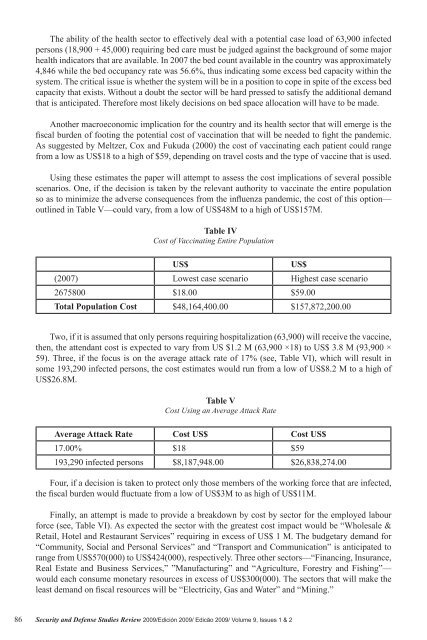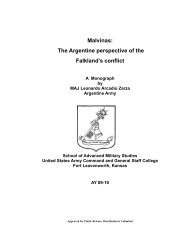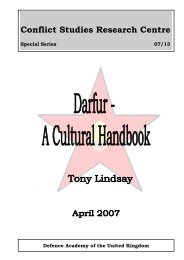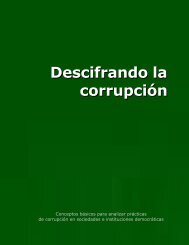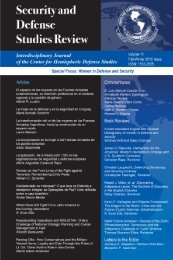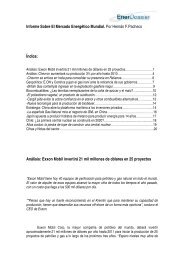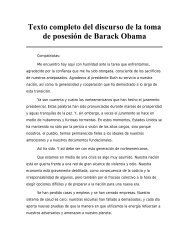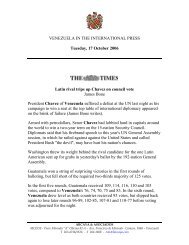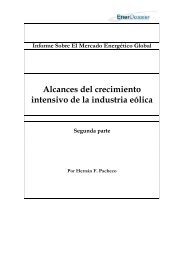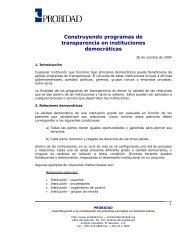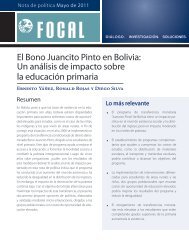The ability of the health sector to effectively deal with a potential case load of 63,900 infectedpersons (18,900 + 45,000) requiring bed care must be judged against the background of some majorhealth indicators that are available. In 2007 the bed count available in the country was approximately4,846 while the bed occupancy rate was 56.6%, thus indicating some excess bed capacity within thesystem. The critical issue is whether the system will be in a position to cope in spite of the excess bedcapacity that exists. Without a doubt the sector will be hard pressed to satisfy the additional dem<strong>and</strong>that is anticipated. Therefore most likely decisions on bed space allocation will have to be made.Another macroeconomic implication for the country <strong>and</strong> its health sector that will emerge is thefiscal burden of footing the potential cost of vaccination that will be needed to fight the p<strong>and</strong>emic.As suggested by Meltzer, Cox <strong>and</strong> Fukuda (2000) the cost of vaccinating each patient could rangefrom a low as US$18 to a high of $59, depending on travel costs <strong>and</strong> the type of vaccine that is used.Using these estimates the paper will attempt to assess the cost implications of several possiblescenarios. One, if the decision is taken by the relevant authority to vaccinate the entire populationso as to minimize the adverse consequences from the influenza p<strong>and</strong>emic, the cost of this option—outlined in Table V—could vary, from a low of US$48M to a high of US$157M.Table IVCost of Vaccinating Entire PopulationUS$US$(2007) Lowest case scenario Highest case scenario2675800 $18.00 $59.00Total Population Cost $48,164,400.00 $157,872,200.00Two, if it is assumed that only persons requiring hospitalization (63,900) will receive the vaccine,then, the attendant cost is expected to vary from US $1.2 M (63,900 ×18) to US$ 3.8 M (93,900 ×59). Three, if the focus is on the average attack rate of 17% (see, Table VI), which will result insome 193,290 infected persons, the cost estimates would run from a low of US$8.2 M to a high ofUS$26.8M.Table VCost Using an Average Attack RateAverage Attack Rate Cost US$ Cost US$17.00% $18 $59193,290 infected persons $8,187,948.00 $26,838,274.00Four, if a decision is taken to protect only those members of the working force that are infected,the fiscal burden would fluctuate from a low of US$3M to as high of US$11M.Finally, an attempt is made to provide a breakdown by cost by sector for the employed labourforce (see, Table VI). As expected the sector with the greatest cost impact would be “Wholesale &Retail, Hotel <strong>and</strong> Restaurant Services” requiring in excess of US$ 1 M. The budgetary dem<strong>and</strong> for“Community, Social <strong>and</strong> Personal Services” <strong>and</strong> “Transport <strong>and</strong> Communication” is anticipated torange from US$570(000) to US$424(000), respectively. Three other sectors—“Financing, Insurance,Real Estate <strong>and</strong> Business Services,” ”Manufacturing” <strong>and</strong> “Agriculture, Forestry <strong>and</strong> Fishing”—would each consume monetary resources in excess of US$300(000). The sectors that will make theleast dem<strong>and</strong> on fiscal resources will be “Electricity, Gas <strong>and</strong> Water” <strong>and</strong> “Mining.”86<strong>Security</strong> <strong>and</strong> <strong>Defense</strong> <strong>Studies</strong> <strong>Review</strong> 2009/Edición 2009/ Edicão 2009/ Volume 9, Issues 1 & 2
Table VICost by SectorSectors Employed Est. Attack_Rate Cost US$Goods-ProducingSectorAgriculture, Forestry,Fishing2007 % Lower-costscenario402600Upper-cost scenario207000 10.00% $372,600.00 $1,221,300.00Mining 8200 15.00% $22,140.00 $72,570.00Manufacturing 69400 25.00% $312,300.00 $1,023,650.00Construction AndInstallationServices Sector 732200Transport, Storage <strong>and</strong>CommunicationFinancing, Insurance,Real Estate <strong>and</strong>Business ServicesCommunity, Social <strong>and</strong>Personal ServicesElectricity Gas <strong>and</strong>WaterWholesale <strong>and</strong> Retail,Hotels <strong>and</strong> RestaurantservicesIndustry NotSpecified118000 10.00% $212,400.00 $696,200.0078600 30.00% $424,440.00 $1,391,220.0066800 25.00% $300,600.00 $985,300.00317200 10.00% $570,960.00 $1,871,480.007700 10.00% $13,860.00 $45,430.00261900 25.00% $1,178,550.00 $3,863,025.002200 10.00% $3,960.00 $12,980.00Total 1137000 $3,411,810.00 $11,183,155.00ConclusionBecause of data limitation <strong>and</strong> the uncertainty that circumscribe the outcomes of a p<strong>and</strong>emic theassumptions built into the paper are necessarily subjective. This notwithst<strong>and</strong>ing the paper providesa measure of some of the potential adverse economic consequences that may result from an influenzap<strong>and</strong>emic.One such consequence is the fiscal burden relating to the provision of vaccines <strong>and</strong> other medicalsupplies. Obviously the cost of providing vaccines will be one part of the fiscal millstone inherentin facing such a challenge, the other part will be the expected reduction in tax revenue, which isestimated to be in the range of JA$1.04B, assuming a taxation rate of 40% of GDP.In addition to these fiscal implications, the institutional capacity of the public health care systemwill come under severe pressure to cope with increasing dem<strong>and</strong> for health care in the short run. Tomitigate some of the potential problems the relevant authorities must channel resources to the sectorin an effort to improve its readiness. Failure to do so can create the potential for severe disturbancesin the society caused by further economic decline on an already heavily-burden society. Specialattention has to be paid to the security forces along with the other essential services, <strong>and</strong> prioritygiven to their vaccination. Otherwise, the risk of depleted <strong>and</strong> overtaxed ranks among the institutionsof law <strong>and</strong> order will significantly increase the potential for civil unrest.<strong>Security</strong> <strong>and</strong> <strong>Defense</strong> <strong>Studies</strong> <strong>Review</strong> 2009/Edición 2009/ Edicão 2009/ Volume 9, Issues 1 & 2 87
- Page 4 and 5:
Document: Speech on “Security, In
- Page 6 and 7:
6Security and Defense Studies Revie
- Page 8 and 9:
un tema de seguridad y defensa porq
- Page 10 and 11:
Los Intereses de la República Popu
- Page 12 and 13:
En el marco estratégico descrito e
- Page 14 and 15:
Works (FAW), Geeley, Dongfeng, y Ch
- Page 16 and 17:
interés en participar en el yacimi
- Page 18 and 19:
al emplear personas locales en todo
- Page 20 and 21:
había un banco en Colombia especia
- Page 22 and 23:
ehén de los FARC, escribe de siete
- Page 24 and 25:
estadounidenses en el futuro, y por
- Page 26 and 27:
26Security and Defense Studies Revi
- Page 28 and 29:
Existe numerosa literatura que trat
- Page 30 and 31:
La Tabla 1.1, demuestra que el apor
- Page 32:
Los cuestionamiento a este modelo d
- Page 35 and 36: ….derogaremos la Ley del Cobre y
- Page 37 and 38: Figura 4.3.Aporte de CODELCO por ve
- Page 39: Figura 6.Elaboración propia distri
- Page 42 and 43: de los proyectos de defensa necesit
- Page 44 and 45: En el caso de las inversiones en de
- Page 46 and 47: Anexo 1PROTOCOLO DE ACUERDO QUE ACO
- Page 48 and 49: OECD. “Models of Public Budgeting
- Page 50 and 51: proyectos nacionales y democrático
- Page 52 and 53: DesprofesionalizaciónEn la región
- Page 54 and 55: Según algunos autores, “no sorpr
- Page 56 and 57: (antinarcóticos), la Guardia Coste
- Page 58 and 59: supervigilen las acciones intrusiva
- Page 60 and 61: Quizás una de las fallas provenga
- Page 62 and 63: Junto con ello se elaboró una nuev
- Page 64 and 65: Colombia). Por otro, hay una serie
- Page 66 and 67: Maldonado, Carlos, “Profesionalis
- Page 68 and 69: policías y militares no ha estado
- Page 70: La relación entre fuerzas militare
- Page 73 and 74: dictaduras. En aquellos con más tr
- Page 75 and 76: efectos de planificación se ha hab
- Page 77 and 78: BibliografíaAguila, Ernesto y Mald
- Page 79 and 80: Sherman, Lawrence. et.al. 1973. Tea
- Page 81: Influenza Pandemic and its National
- Page 84 and 85: and restaurant services” is expec
- Page 88 and 89: BibliographyAlmond, D. and B. Mazum
- Page 90 and 91: El trabajo parte del supuesto de qu
- Page 92 and 93: es tanto una elección voluntaria c
- Page 94 and 95: Por otro lado, Rusia nunca ha visto
- Page 96 and 97: La Organización del Tratado del At
- Page 98 and 99: liquidez internacional pero tambié
- Page 100 and 101: petróleo recientemente descubierta
- Page 102 and 103: Dentro de este esquema, Estados Uni
- Page 104 and 105: 104Security and Defense Studies Rev
- Page 106 and 107: minimize a number of attempts at fo
- Page 108 and 109: kidnapping, of Maria Edith de Deber
- Page 110 and 111: The political campaign that resulte
- Page 112 and 113: would carry out the more violent ta
- Page 114 and 115: of the EPP so far, is the relative
- Page 117 and 118: to accept ideas, policies or course
- Page 119 and 120: eing killed themselves—the idea t
- Page 122 and 123: In Latin America, the role played b
- Page 124 and 125: the Church to be given to the dying
- Page 126 and 127: from providing military chaplains t
- Page 128 and 129: Perhaps one of the clearest example
- Page 130 and 131: was prepared by the Office of the C
- Page 132 and 133: 132Security and Defense Studies Rev
- Page 135 and 136: Keynote Speech by Dr. Frank O. Mora
- Page 137 and 138:
If successful, these infrastructure
- Page 139 and 140:
Security, Intelligence and the Role
- Page 141 and 142:
Clearly, security, intelligence and
- Page 143 and 144:
Contratapa(Contratapa offers, in a
- Page 145 and 146:
efforts have become intertwined; fo
- Page 147 and 148:
comprensión de sus valores y cultu


